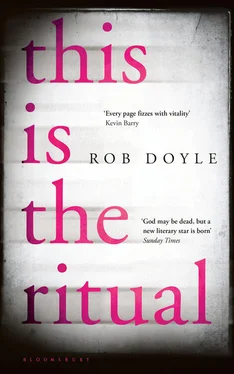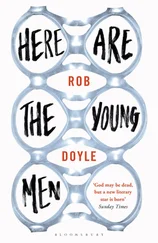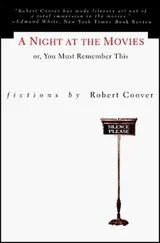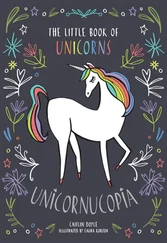Rob Doyle - This is the Ritual
Здесь есть возможность читать онлайн «Rob Doyle - This is the Ritual» весь текст электронной книги совершенно бесплатно (целиком полную версию без сокращений). В некоторых случаях можно слушать аудио, скачать через торрент в формате fb2 и присутствует краткое содержание. Год выпуска: 2016, Издательство: Bloomsbury Publishing, Жанр: Современная проза, на английском языке. Описание произведения, (предисловие) а так же отзывы посетителей доступны на портале библиотеки ЛибКат.
- Название:This is the Ritual
- Автор:
- Издательство:Bloomsbury Publishing
- Жанр:
- Год:2016
- ISBN:нет данных
- Рейтинг книги:5 / 5. Голосов: 1
-
Избранное:Добавить в избранное
- Отзывы:
-
Ваша оценка:
- 100
- 1
- 2
- 3
- 4
- 5
This is the Ritual: краткое содержание, описание и аннотация
Предлагаем к чтению аннотацию, описание, краткое содержание или предисловие (зависит от того, что написал сам автор книги «This is the Ritual»). Если вы не нашли необходимую информацию о книге — напишите в комментариях, мы постараемся отыскать её.
This is the Ritual — читать онлайн бесплатно полную книгу (весь текст) целиком
Ниже представлен текст книги, разбитый по страницам. Система сохранения места последней прочитанной страницы, позволяет с удобством читать онлайн бесплатно книгу «This is the Ritual», без необходимости каждый раз заново искать на чём Вы остановились. Поставьте закладку, и сможете в любой момент перейти на страницу, на которой закончили чтение.
Интервал:
Закладка:
Passolet fled that same night, terrified by what he had intended to do, the madness that had possessed him. He hurried by moonlight along rural back-roads, imagining unspeakable forms pursuing him through the darkness. Eventually he reached a stream, which his intuition told him was a safe place — evil could not touch him here. He carved a cross in the earth with his stolen knife, then lay down and slept. When he awoke, the sun was shining in a clear morning sky. A faint breeze stirred the rows of corn growing alongside the grassy bank. Birds chirped, and the stream gurgled gently by his head. Passolet felt the warmth of the sun on his face; he knew that this warmth was the hand of the Lord, and that it offered solace, and deliverance from the devils within; he knew too that he had to prove his ardour to deserve this beneficence. Still lying on his back, Passolet took the long, heavy knife from out of his trouser pocket. With his left hand he unfreed his penis and stretched it out above him. He did not manage to sever the penis completely before he passed out; the damage, however, was enough to ensure he would be wholly impotent for the rest of his life. Passolet was found by a farmer’s young son who was out cycling by the river, a bloody patch spreading from his groin. Had he been left there much longer, he would have bled to death.
Passolet did not write about this shocking episode for many years. I had agonised, while preparing to interview him, about whether I would bring it up, finally deciding that to do so would serve no purpose other than to feed the salacious curiosity I detested in both the press and myself. After being hospitalised, Passolet was committed to yet another institution, this one in an affluent Paris suburb, his lengthy stay there paid for by the Bresson-Levaints. Thus began the years of Passolet’s long convalescence. Initially, he spent most of his days sitting out in the well-tended grounds of the institution, staring into space, or drawing childish pictures of obese cats with blank, circular faces. Silvia Bresson-Levaint often visited him, on occasion bringing Celine Begadour, who had recognised herself in the pages of Passolet’s book. One spring day in 1986, three years into Passolet’s stay, Celine brought along her young daughter, Beatrice. Passolet said little during the visit, but Celine would later recall, in conversation with a Belgian journalist, that tears had flowed down his face as the dark-haired little girl stood by his side, watching him curiously. Passolet later claimed that it was the sight of Beatrice, the trust and gentleness in her manner, which marked the beginning of his recovery. ‘I could have killed her with my bare hands,’ he said. ‘But she had no fear of me, only this miraculous trust. That was very moving.’ When Passolet finally left the institution a year and a half later, he sought out Celine to thank her for her visits. Discovering that Celine had been widowed some years previously, Passolet proposed to her. At first, she refused — Passolet was, after all, a man who had been institutionalised for years after committing a violent and inexplicable act. Moreover, he was impotent. Yet they remained friends, and Passolet persisted in his declarations of love. Seeing that he moved confidently again in his old social and literary circles ( Cities in Crystal had grown in reputation during Passolet’s convalescent years), and was in a position to provide for her daughter and herself, Celine eventually relented. They were married, and lived together in an apartment in the ninth arrondissement.
Now in his mid-thirties, Passolet enjoyed the first taste life had granted him of a normal, uncomplicated happiness. Re-accessing the creative fount that had been blocked throughout the years of his confinement, Passolet completed Heaven , the book he had started so long before, and immediately began what for my younger self was his essential work, European Graveyards . Published a year after Heaven , a realistic novel depicting the rapture and disintegration of a young Viennese pianist, the later work did not enjoy the same commercial success, but that came as a surprise to nobody. European Graveyards is a strange, difficult, cold book, which casts its affectless gaze across the darkest regions of the twentieth century, weaving historical vignettes with chillingly neutral depictions of Passolet’s own madness and institutionalisation. (The penis-slicing episode is alluded to but not depicted; it would not be until his most straightforwardly autobiographical book, Eggshells , in 1999, that Passolet would write directly about it.) In one chapter, enclosed between essays on ‘rock’n’roll terrorists’ and the ‘eternal howling’ of the Dresden dead, the author Jean-Pierre Passolet has already died. In a suburban psychiatric institution — evoked as a Kafkan or Kunderan waiting-room to a sinister beyond — Passolet’s corpse is placed sitting in a chair, and various figures from his life — Celine, Beatrice, the Bresson-Levaints, the white-vested gypsy, his mother — enter the room to deliver monologues that touch on, but are not restricted to, their relationship with the deceased. A slender, faceless man in a tuxedo appears and announces that he has ‘no quotidian penis’. He undoes his flies to prove it, whilst insisting that the fingers of his left hand are ‘confident, slithering’ penises. Another visitor is an extremely old woman whose body is in an advanced stage of decomposition; she does not say anything, just stands before Passolet’s artificially shiny corpse for a very long time, as if waiting for him to speak. Finally the rotting woman mounts Passolet’s corpse and begins straddling him, fucking him slowly at first, but soon reaching a violent climax — at which point her head falls off, rolls across the floor, and bursts into flames.
The book is too long — over six hundred pages — but there are moments of eerie, enigmatic beauty which, at least for my eighteen-year-old self, made it seem a devastating work of art. The final section was my favourite: in it, Passolet imagines the cities of Europe emptied of people; not in ruins, not razed or ransacked, but majestic in their desolation, as birds squawk and soar across hazed skies. ‘The world has not ended,’ he tells us, ‘but people have faded away, and have done so willingly, with a lightness of spirit, a lucid joyfulness, as if walking collectively into a great chasm, a gaping maw.’ This section, like so much in Passolet, is offered without explanation. It is not difficult to see why so many readers dismiss Passolet as a particularly glaring exemplar of French pretentiousness, of literary froth, but I have never shared this view.
Passolet was delighted by the reception that both books found among the French literary establishment. However, lasting happiness was never to be his fate. Within six months of the publication of European Graveyards , he and Celine were divorced. Celine successfully appealed for a restraining order to be placed on Passolet, barring him from seeing Beatrice or her. In court, she cited the growing signs that Passolet was relapsing into hallucination and irrational behaviour. (‘Love’, Passolet had written at another time, ‘is itself a hallucination.’) Within three months of the divorce, Celine had remarried, to a chef from a restaurant near the apartment she had shared with Passolet. Like so many men before him, Passolet took to the bottle in the aftermath of his wife’s desertion, and appeared destined to sink once more into the chaotic life that Celine had done so much to lift him out of. In one notorious incident, he was beaten up outside a respectable Montmartre restaurant, having hurled anti-Semitic insults at a man who was dining with his eighty-nine-year-old mother (neither the man nor his mother were Jewish). Passolet had his jaw and nose broken and appeared in the French press under such headlines as ‘Traitor to Literature’ ( Le Monde ) and ‘Go Back to the Madhouse, Jean-Pierre!’ ( Le Parisien ). When, not long after this incident, Silvia Bresson-Levaint died following a struggle with breast cancer, Passolet felt he could not stay in Paris. He stopped drinking and moved to Bruges, where he taught an evening course in creative writing at the university. At a literary conference in London he met Lorraine Holden, remarried, and moved to the UK.
Читать дальшеИнтервал:
Закладка:
Похожие книги на «This is the Ritual»
Представляем Вашему вниманию похожие книги на «This is the Ritual» списком для выбора. Мы отобрали схожую по названию и смыслу литературу в надежде предоставить читателям больше вариантов отыскать новые, интересные, ещё непрочитанные произведения.
Обсуждение, отзывы о книге «This is the Ritual» и просто собственные мнения читателей. Оставьте ваши комментарии, напишите, что Вы думаете о произведении, его смысле или главных героях. Укажите что конкретно понравилось, а что нет, и почему Вы так считаете.












